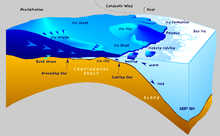Ice dome
An ice dome ( English ice rise ) is an ice mass resting on a rock, which is either completely surrounded by an ice shelf , or partially by an ice shelf and partially by the open sea or ice-free land. The subsurface can be completely below sea level . No rock lies bare on the surface. An ice dome forms where the floating ice shelf that flows out to sea is obstructed by a rocky elevation on the sea floor. It is mostly fed by local precipitation. The flow of the ice is directed radially outwards, regardless of the flow direction of the ice shelf.
Ice domes occur mainly in the Antarctic ice shelf areas, especially in the Ronne Ice Shelf . The larger of these reach sizes of 50 km by 200 km or 10,000 km². The largest ice dome is Berkner Island , which despite its name is not an island , with a size of 145 km by 372 km.
Examples of larger ice domes
- Berkner Island (no island despite the name )
- Crary Ice Rise
- Korff Ice Rise
- Henry Ice Rise
- Fowler Ice Rise
- Skytrain Ice Rise
- Dott Ice Rise
swell
- Hans-Peter Kosack : The polar research . A data book about the natural, cultural and economic conditions and the exploration history of the polar regions. Reprint of the 1st edition from 1967. Springer-Verlag, 2013, ISBN 978-3-663-00292-5 , pp. 135 , doi : 10.1007 / 978-3-663-02205-3 ( limited preview in Google Book search).
- Bernadette Hince: The Antarctic Dictionary . A Complete Guide to Antarctic English. Csiro Publishing, 2000, ISBN 0-9577471-1-X , p. 184 ( limited preview in Google Book search).
- Kenichi Matsuoka et al .: Antarctic ice rises and rumples: Their properties and significance for ice-sheet dynamics and evolution . In: Earth Science Reviews . tape 150 , 2015, p. 724-745 , doi : 10.1016 / j.earscirev.2015.09.004 (English).
Individual evidence
- ^ Glossary of generic geographical names on the website of the Standing Committee on Geographical Names (StAGN), accessed on December 8, 2017.
Web links
- Definition on the Australian Antarctic Data Center website
